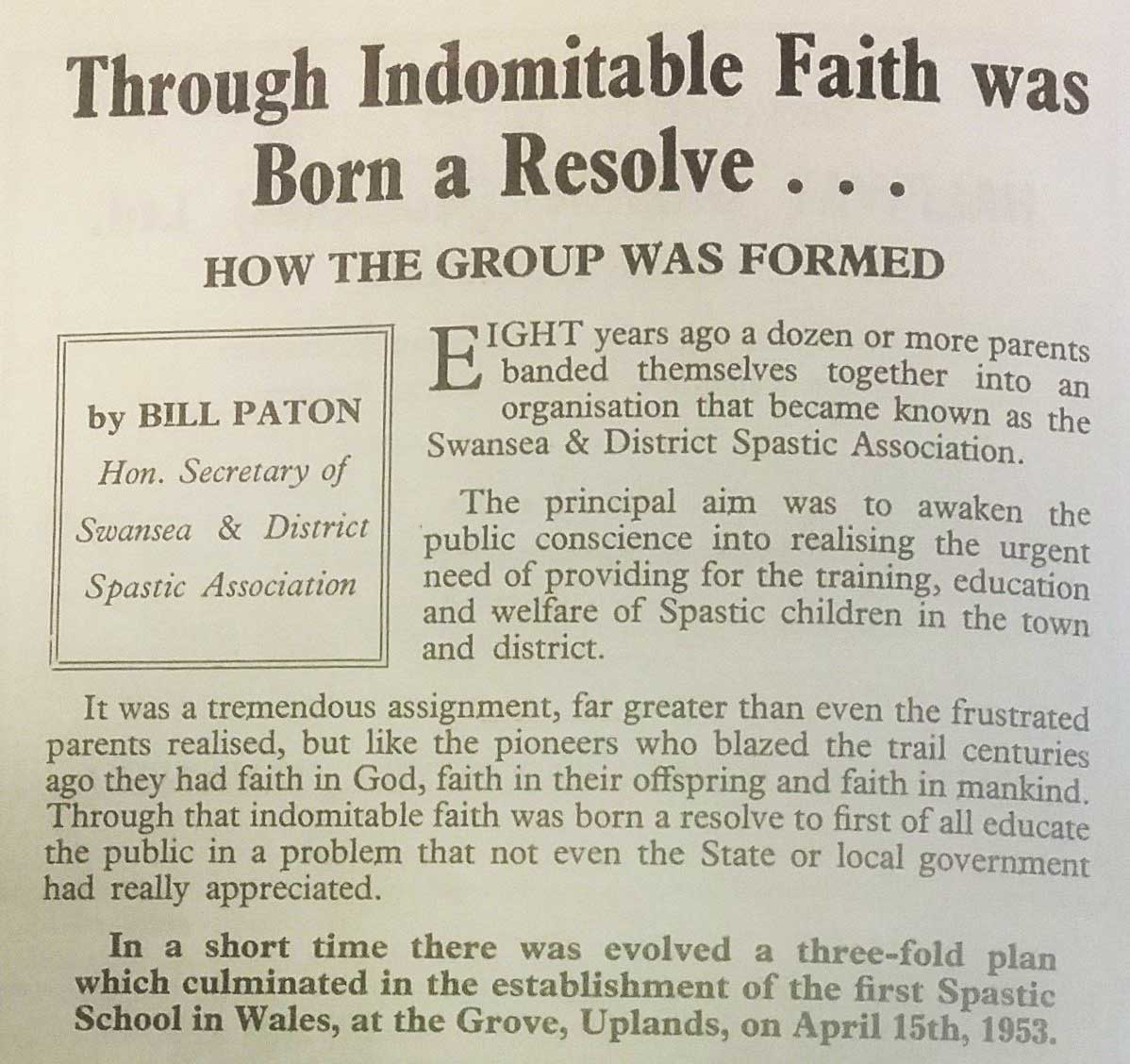The History of Longfields
Longfields Association, originally known as Swansea & District Spastic Association, was established in 1952. It was started by a group of parents of children with cerebral palsy. These parents began to question the lack of educational provision and other services for their children and campaigned to raise awareness of this. Through their hard work and efforts, they raised the profile of their children and the injustices they faced. They promoted their cause through lobbying local and national government; challenging medical opinion; winning community support; securing widespread celebrity backing and patronage; and campaigning prominently in local and national media.
This is a synopsis of the Association’s history that highlights the hard work and determination of the founding members, supporters, volunteers and staff who contributed to the success of Longfields. It is not possible in the available space to acknowledge all individuals but without their contribution the Association would not have survived for nearly sixty years
1950s
Their first formal meeting was at Clarks College, Swansea where it was unanimously agreed to form the Association. At the time of its inception it was known as Swansea and District ‘Spastic’ Association. They established the first school in Wales for children with cerebral palsy with the ‘school room’ rented in the Grove, Uplands.
In 1955, the house at West Cross ‘Longfields’ was bought at a cost of £5,100 by Mrs Felicie Philippe, a philanthropist living in London. She gave this house as a gift to the Association. This enabled the members to open the first nursery in Wales for children with cerebral palsy as well as an Adolescent Training Centre.
1960s
A new building, the Work Centre, was built in the grounds of Longfields and opened on 20th November 1962. The Work Centre provided employment for people with cerebral palsy, winning contracts from local businesses such as Mettoys and Addis. Light industrial work was undertaken as well as the pursuit of handicrafts. In addition, the Print Room was very busy meeting a range of printing orders. These new ventures meant that the Association had stands at the Gower Show and the Summer County Show at Singleton. They also took part at the Trade and Industries Fair at the Patti Pavilion.
1970s
An extension was built to the Work Centre to move and accommodate the nursery which had been run at Longfields. Following alterations to the house, a residential unit was created to provide respite opportunities for families.
One of the rooms in the residential unit was called the ‘Tom Jones’ room. The Association had made links with the ‘Bridge across the Pond’ chapter of the Tom Jones International Fan Club. Their fund-raising activities went towards furnishing a bedroom at the unit and a framed portrait of Tom was hung on the wall.
During the early 1970s the age range of people who went to Longfields was between 3 and 54. By the mid 1970s all school age children had been transferred to Morfydd House, a local authority run school.
1980s
The 1980s was a time of change with a move away from Work Centre based activities towards community programmes, with more of a focus on life skills such as managing budgets, cooking and social skills. However, craft activities and art therapy still played an important role in the day to day activities at the Centre.
The Association participated in the Computer Service Project for the Disabled which enabled learning and education. A group at Longfields also attended Community Theatre Project workshops and began to learn about self-advocacy.
1990s
During the 1990s, in line with similar organisations, the Association changed its name. It became Longfields Association instead of Swansea & District Spastic Association. The word ‘spastic’ had become a derogative term in society rather than just being descriptive of a symptom of cerebral palsy. This change of name was an important decision for the Association.
The need to demonstrate quality service provision led to the Association achieving the Investors in People Award towards the end of the decade. This was an achievement of which they were justly proud and they also had a Group Achievement Award from the national charity Scope.
An extract from the Annual Report 1999 on the Investors in People Award
Then, in March, after many months of assessment, we heard that we had been successful in our application for the prestigious “Investors in People” Award.
The Assessor, Mr. Ian Webb said at the time that he had been impressed by the relaxed atmosphere at Longfields and by the positive attitude shown by representative members of staff, committees, parents and volunteers to whom he had spoken during his several visits to Longfields, and that he had no hesitation in recommending the award to the adjudicating panel.
The presentation plaque was later received, and on 19th May was duly unveiled by Mr. Roy Noble of B.B.C. Wales. Many of our friends were present on this occasion and stayed to enjoy an excellent buffet provided by David.
The third award is a ‘Group Achievement Award’ from Scope, which will be presented at this Annual General Meeting, and we are very pleased to receive this recognition.
Congratulations are in order to everyone who has played a part in gaining these awards. To retain the “Investors in People” Award we must maintain high standards of training and monitoring systems which will be reassessed at set intervals, and to this end during the past months we have stepped up staff training in several areas. Staff members have attended courses on computer work, first aid, travel risk, fund-raising, health and safety and hygiene, and further courses on medication, manual handling and minibus driving are planned for the near future.
The organisation continued as a day centre and charitable organisation merging with Walsingham Support in 2010.
Little did the founder members think that the organisation they created in the 1950s would be in existence for nearly 60 years!









